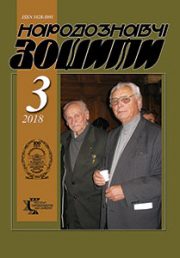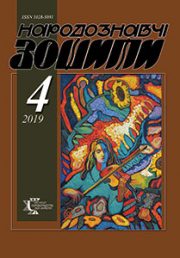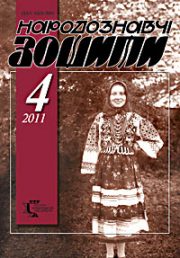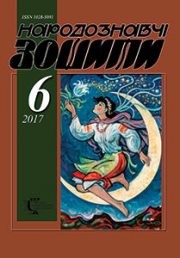The Ethnology Notebooks. 2023. № 3 (171), 742—776
UDK [39:746.1/.3.016.4.012.011.26-037](477.8:474.5)”18/19″:930.2
DOI https://doi.org/10.15407/nz2023.03.742
TRADITIONAL TOWELS OF WESTERN UKRAINE AND LITHUANIA: COMMON AND DISTINCTIVE FEATURES OF THE DECOR
NYKORAK Оlena
- ORCID ID: https://orcid.org/0000-0003-0887-8929
- Doctor in Art Studies, Professor,
- Leading Researcher,
- The Ethnology Institute of the National Academy of Sciences of Ukraine,
- Folk Art Department
- 15, Svoboda Avenue, 79000, Lviv, Ukraine,
- Contacts: e-mail: olenanykorak@gmail.com
KUMPIKAITĖ Eglė
- ORCID ID: https://orcid.org/0000-0002-4786-8144
- Ph.D. in Technical Sciences, associate professor
- Kaunas University of Technology
- Faculty of Mechanical Engineering and Design
- Department of Production Engineering
- 56 Studentu str., LT-51424, Kaunas, Lithuania,
- Contacts: e-mail: egle.kumpikaite@ktu.lt
MILAŠIENĖ Daiva
- ORCID ID: https://orcid.org/0000-0002-1833-1217
- Ph.D. in Technical Sciences, associate professor
- Kaunas University of Technology
- Faculty of Mechanical Engineering and Design
- Department of Production Engineering
- 56 Studentu str., LT-51424, Kaunas, Lithuania,
- Contacts: e-mail: daiva.milasiene@ktu.lt
RUKUIŽIENĖ Žaneta
- Ph.D. in Materials Science, lecturer,
- Kaunas University of Technology
- Faculty of Mechanical Engineering and Design
- Department of Production Engineering
- 56 Studentu str., LT-51424, Kaunas, Lithuania,
- Contacts: e-mail: zaneta.rukuiziene@ktu.lt
Abstract. The article was written based on the results of the Ukrainian-Lithuanian interdisciplinary R&D projects «Ornamentation of Western Ukrainian and Lithuanian Folk Textile: Universal and Unique Parameters» (2018—2019) and «Unique Technologies of Ethnographic Textile: Experience of Preservation in Western Ukraine and Lithuania» (2022—2023) (the project have been supported by the Lithuanian Research Council and the Ministry of Education and Science of Ukraine [grant number in Lithuania S-LU-22-5]). The absence of a comparative analysis of the most remarkable signs of the originality of Western Ukrainian and Lithuanian towels` decor determined the relevance and novelty of the study.
The article’s purpose consists of the identification of technical parameters and artistic and stylistic originality in the decor tradition of Western Ukrainian and Lithuanian homespun towels.
The object of the study is the traditional towels of Western Ukraine and Lithuania, and the subject is the common and distinctive features of their decor.
The methodological basis of the work was an art, structural, and comparative-historical analysis of the composition schemes formation principles, and individual ornamental motifs, which contributed to the identification of folk towels decoration characteristic features in the studied areas of Ukraine and Lithuania at the end of the XIX and the first half of the XX centuries.
The article’s source base was: professional publications of Ukrainian and Lithuanian scientists in the field of traditional weaving; material items from the collections of the investigated museums of Lviv, Kolomyia, Kosov, Ivano-Frankivsk, Krylos, Radyvylov, Lutsk, Vilnius, Kaunas, Rumљiљkės, Kretinga, Klaipėda; the authors’ long-term field research materials in Ukraine and Lithuania.
Different types of Ukrainian and Lithuanian towels are analyzed in the article, and regional and local features of their structure, texture, ornament motifs, variability of composition schemes, and coloring are revealed. The unique and universal features of Ukrainian items` ornamentation in various historical and ethnographic regions of the Western region of Ukraine and similar items in Lithuania are noted.
The study of Western Ukrainian and Lithuanian folk towels proved the existence of a significant number of types of woven items and their local variants in these areas. The comparative art analysis of the Western Ukrainian and Lithuanian items decoration made it possible to identify a number of common and distinctive artistic and aesthetic features, ethnic features of identity, and local originality, which are a significant component of the national artistic heritage of Ukraine and Lithuania.
Keywords: western part of Ukraine, Lithuania, weaving, traditional towels, ornament, composition, coloration.
Received 30.05.2023
REFERENCES
- Sydorovych, S. (1979). Art Fabrics of UkrSSR Western Regions. Kyiv: Naukova Dumka [in Ukrainian].
- Oliinyk, O. (2017). The Folk Weaving of Pokuttia: Tradition and Modernity. The Ethnology Notebooks, 2 (134), 251—274. DOI: 10.15407/nz2017.02.251 [in Ukrainian].
- Nykorak, O. (1988). Modern Art Cloths of Ukrainian Carpathian Mountains. Kyiv: Naukova Dumka [in Ukrainian].
- Nykorak, O. (2004). The Ukrainian Traditional Folk Cloths of XIX and XX cc. Part I. Interior Cloths (Based on Materials from Ukrainian Western Regions). Lviv: Ethnology Institute of NAS of Ukraine [in Ukrainian].
- Nykorak, O. (2004). The Ukrainian Ritual Cloth-Rushnyk in traditional customs and rituals. Ukrainian Rushnyk: Rituals and Symbols [Exhibition May-October 2004, Winnipeg, Canada]. Kyiv: Rodovid.
- Andrushko, L. (2010). Ukrainian Towel as a Multifunctional Sacred Work of Folk Art: Function, Typology, Semantics, Artistic Features. Lviv [in Ukrainian].
- Herus, L. (2018). Bread and Cloth in Ukrainian Rituality: Functions and Semantics. The Ethnology Notebooks, 5 (143), 1096—1105. DOI https://doi.org/10.15407/nz2018.05.1096 [in Ukrainian].
- Pavlutskyi, H. (1927). Ukrainian Ornament History. Kyiv: Ukrainian Academy of Science [in Ukrainian].
- Stankevych, M. (2003). To the Issue of Ukrainian Folk Art National Paradigms. The Ethnology Notebooks, 1—2, 176—179 [in Ukrainian].
- Stankevych, M. (2004). Pattern or Ornament? (Terminological, Ontological View and Not Only). Authenticity of Art (Pp. 155—170). Lviv [in Ukrainian].
- Selivachov, M. (2005). Lexicon of Ukrainian Ornamentation (Iconography, Nomination, Styles, Typology). Kyiv: Ant [in Ukrainian].
- Nykorak, O. (2010). Ukrainian Folk Ornamental Cloths: Comparative Characteristic. Notes Shevchenko Scientific Society. Vol. 259 (CCLIX). Labor Section of Ethnography and Folklore (Pp. 179—210). Lviv[in Ukrainian].
- Balcikonis, J., Glemzaite, M., Kairiukstyte-Jaciniene, H., Mikenaite A. (Eds.). (1962). Lithuanian Folk Art. Fabrics II. Vilnius: Valstybinė grozinės literaturos
- leidykla [in Lithuanian].
- Tallat-Kelpsaite-Niunkiene, G. (1966). Lithuanian Folk Fabrics (lit. Towels). Proceedings of the Academy of Sciences of the Lithuanian SSR. Serie A, 1 (20),
- 107—120 [in Lithuanian].
- Bernotaite-Beliauskiene, D. (2016). Lithuanian Folk Textiles. Towels. Vilnius: Lietuvos Dailes muziejus [in Lithuanian].
- Bernotaite-Beliauskiene, D. (2018). For Body and Soul: Towels. 1 Part. Folk Culture, 5, 76—85 [in Lithuanian].
- Bernotaite-Beliauskiene, D. (2018). For Body and Soul: Towels. 2 Part. Folk Culture, 6, 66—74 [in Lithuanian].
- Benedikiene, R. (2019). Dzuki rags: A set of Towels of the Alytus Local History Museum. Alytus: Alytaus krastotyros muziejus [in Lithuanian].
- Neniene, I. (2010). Textile traditions of Zanavyki: XIX — the Beginning of the XXI Centuries. Vilnius: Technologija [in Lithuanian].
- Savoniakaite, V. (1998). Fabrics in rural culture. Lithuanian geometric patterns in the XIX—XX Centuries. Vilnius: Alma littera [in Lithuanian].
- Kudirka, J. (1984). Features of Folk Art (Pp. 95—102). Kaunas [in Lithuanian].
- Kudirka, J. (1989). Children and Folk Art (Pp. 93—107). Vilnius [in Lithuanian].
- Kumpikaite, E., Kot, L., Nenartaviciute, E. (2014). Comparable Analysis of Folk Home Textile of East Prussia in Territories of Lithuania and Poland, Open
- Journal of Social Sciences, 10 (Vol. 2, pp.~19—29).
- Ragaisiene, A., Kumpikaite, E., Rukuiziene, Z. (2014). Preservation of Lithuanian Folk Identity in Ethnographic Fabrics. Proceedings of the 14th AUTEX world
- textile conference (Pp. 1—5), Bursa.
- Kumpikaite, E., Ragaisiene, A., Rukuiziene, Z., Kot, L., Nenartaviciute, E. (2013). Checked and Striped Lithuanian Home Textile Folk Fabrics. Proceedings of
- the 13th AUTEX World Textile Conference (Pp. 1—5), Bursa.
- Nenartaviciute, E. (1999). Home Weaving in the 1st Half of the 20th Century. Plateliai (Pp. 397—402). Vilnius].
- Museum of Ethnography and Applied Art of the Ethnology Institute of NAS of Ukraine (hereinafter — MEAA) EP—63240.
- Volyn Museum of Local Lore (hereinafter — VMLL) D—1360.
- VMLL D—568, 567.
- Rivne Region Museum of Local Lore (hereinafter — RRMLL) T—2197.
- Andrei Sheptytskyi National Museum in Lviv (hereinafter — NML) NMT—2313.
- VMLL D—1056.
- RRMLL T—3422.
- Lobachevska, V. (2002). Time tie — Belarusian towel. Minsk: «Belarus» [in Belarusian].
- RRMLL R2—435.
- Kremenets Museum of Local Lore T—225.
- NML T—2993, 1870.
- VMLL R2—435, D—1056, 226, 1077, 739, 1362, 226; R2—1461.
- Klymentii Sheptytskyi Museum of Folk Architecture and Everyday Life (hereinafter — MFAEL) AP—18498, 18499, 18476, 8883.
- VMLL D—1056.
- Nykorak, O., Kumpikaite, E., Herus, L., Nenartaviciute, E., Kozakevych, O., Rukuizene, Z., Kutsyr, T. (2019). Woven Towels of Western Ukrainian and
- Lithuania: Techniques, Decor Functions. The International Young Scientists Conference «Industrial Engineering 2019» (Pp. 124—129). Kaunas: KTU;
- Faculty of Mechanical Engineering and Design.
- Kozakevych, О, & Kutsyr, T. (2022). Ukrainian Polissia Traditional Towels Decor. Traditions and Modern State of Culture and Arts. Collection of Scientific Articles. Iss. 3 (Pp. 615—619). Minsk: Prava i Ekonomika [in Russian].
- The National Museum of Hutsulshchyna & Pokuttia Folk Art named after Yo. Kobrynsky (hereinafter — NMHPFA) № 13606, 14286.
- Chernivtsi Region Art Museum T—1012, 1013, 1014.
- MFAEL AP—1012, 1014, 1016, 43, 483.
- MEAA EP—63240.
- VMLL D—123, 99, 567, 568.
- MEAA EP—76244.
- Ivan Honchar Museum (hereinafter — IHM) T—382.
- VMLL D—305, 274.
- MEAA EP—6246.
- VMLL D—317, 123, 230, 124, 567, 568.
- NML T—1862.
- VMLL D—770, 122, 372, 228.
- RRMLL T—2206, 3095, 2442, 2441.
- RRMLL T—2197, 3658.
- RRMLL T—2206, 2191, 2192.
- IHM T—957, 2313.
- РОКМ Т—2442, 3095.
- VMLL D—84.
- Nykorak, O. (2002). Art Textile. In: Lemko Region (Vol. 2). Spiritual Culture (Pp. 242—255) Lviv [in Ukrainian].
- Transcarpathian Museum of Folk Architecture and Everyday Life (hereinafter — TMFAEL) E—343, 347, 349.
- TMFAEL E—347, 4311, 343, 349.
- T. Lehotskyi Transcarpathian Region Museum of Local Lore (hereinafter — TRMLL) E—3362, 2270.
- TMFAEL E—441, T—3436.
- Kara-Vasyljeva, T. (1997). Art Fabrics and Embroidery of Kholmshchyna and Pidliashshia. In: Borysenko, V. (Ed.). Kholmshchyna and Pidliashshia: Historical and Ethnographic Study (Pp. 232—240). Kyiv: Rodovid [in Ukrainian].
- Hanudel, Z. (1992). Ткацька лексика в українських говорах Східної Словаччини. In: Science Collection of the Ukrainian Culture Museum in Svydnyk (Vol. 18, pp. 245—323). Priashiv [in Ukrainian].
- Mrlin R. (Ed.). (1953). Slovak Folk Art. Bratislava [in Russian].
- TMFAEL E—2698, 3862.
- MEAA EP—65207, 73706, 64859, 64878, 64879,648.
- National Museum of Folk Architecture and Everyday Life of Ukraine (hereinafter — NMFAELU) T—120, 1197.
- TMFAEL E—4581, 2307, 4297.
- TRMLL E—820.
- MEAA EP—64859, 64879.
- National Museum of Ukrainian Folk Decorative Art (hereinafter — NMUFDA) KT—1433.
- НМУНДМ КТ—1636, 3637, 3643, 3644, 3646, 3647, 3634.
- TRMLL E—4297.
- TMFAEL E—2059, 2152, 147, 529, 2069.
- MEAA EP—73707, 65207.
- MFAEL AP—12117, 15330, 16729, 10807.
- NMHPFA № 6525, 6443, 5067, 11979, 14239,10526, 14238, 14249.
- MFAEL T—744.
- NMFAELU KT—354, 2006.
- MEAA EP—79005.
- NMUFDA № 13836, 8515, 10526, 5069.
- Ivano-Frankivsk Region Museum of Local Lore (hereinafter — IFRMLL) T—3235.
- Oliinyk, O. (2017). The Folk Weaving of Pokuttia: Tradition and Modernity. The Ethnology Notebooks, 2 (134), 251—274. DOI: 10.15407/nz2017.02.251 [in Ukrainian].
- NMHPFA № 3137, 10513, 3627.
- IHM T—8620.
- IFRMLL T—139.
- NMHPFA № 14286, 8691.
- NMHPFA № 4520, 14252, 4491.
- IHM T—8620.
- IFRMLL T—41.
- Ternopil Region Museum of Local Lore Тернопільський обласний краєзнавчий музей T—5503.
- Borshchiv Region Communal Museum of Local Lore B—5112.
- NMHPFA № 14252, 6046, 4961, 4228, 4961, 6822, 4491.
- IFRMLL T—521.
- NMHPFA № 4520.
- MFAEL AP—8063.
- MFAEL AP—6288, 6289.
- MFAEL AP—6729, 6643.
- VMLL D—379, 397, 905.
- MEAA EP—23020.
- NML T—2325.
- IHM T—977.
- VMLL D—403, 379, 401.
- RRMLL T—4046.
- IHM T—957.
- RRMLL T—2191.
- VMLL D—133.
- VMLL D—398, 399, 251.
- RRMLL T—3909.
- National Museum of Lithuania (hereinafter — NML) EM—0883.
- Lithuanian National Museum of Art (hereinafter — LNMA) LA–4938.
- ВНМ ЕМ—0893.
- LNMA LA—1127, 2489.
- M. K. Ciurlionis National Museum of Art (hereinafter — CNMA) E—2836, 3003, 2733, 1127.
- Фадзеева В.Я. Беларускі ручнік. Минск: Полымя, 1994. 327 с.
- VMLL D—902, 386, 905.
- NML T—1870.
- VMLL D—386, 397, 379, 902.
- MEAA EP—23020.
- NML T—1870.
- RRMLL T—2068.
- IHM T—962.
- VMLL D—2572.
- MEAA EP—79482.
- IHM T—991.
- NML T—2000.
- VMLL R2—1189.
- VMLL D—1981.
- VMLL D—1724.
- VMLL R2—1189.
- VMLL D—571.
- VMLL D—1181, 2572, 1961.
- NML NMT—2000.
- MEAA EP—22952.
- ИNMA E–5230, NML EM-02466.
- ИNMA Е—6549.
- ИNMA Е—4101, LNMA LA—2798, 1192.
- ИNMA Е—6461, 6549.
- ИNMA Е—6461, 4324, 5106.
- ИNMA Е—6577.
- ИNMA Е—2569.
- ИNMA Е—2795.
- ИNMA Е—1105.
- NML EM—02466.
- ИNMA Е—5106, 6585, 6549, 4101.
- ИNMA Е — 6461, 1466, 1468, 61402.
- Lobachevskaia, V. (2009). Traditional Folk Textile. In: Traditional Art Culture of Belarusians. Vol. 4. Brest Polissia. Book 2. (pp. 753—759). Minsk: Vyssheishaia shkola [in Belarusian].
- Lobachevskaia, O. (2013). Belarusian Folk Textiles. Artistic Foundations, Relationships, Innovations. Minsk: Belarusskaia navuka [in Russian].
- Rarwicka, T. (1976). Weaving Ornamentation of Clothes and Linen Towels of the Northern W.S.C. Lublin region. In: Lublin Studies and Materials. Ethnography, 2. (Pp. 7—62). Lublin: Muzeum w Lublinie [in Poland].







